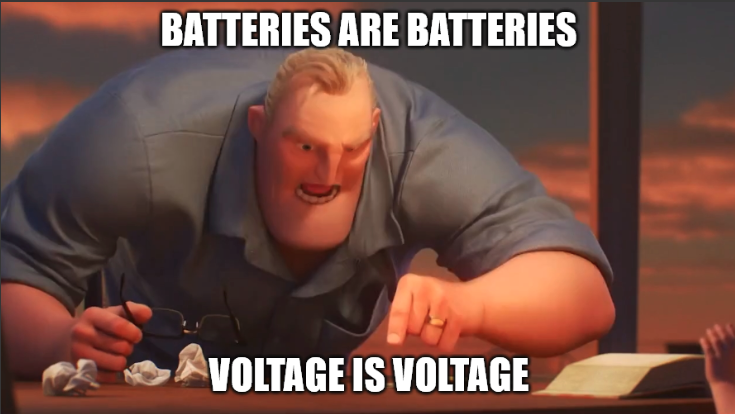(for various reasons I needed to join a mismatched pair of 18v drill and battery, annoyed at how much fun it was)


As long as voltage matches, some batteries at 12v (4S) and others are 24v (6S)
Yes, and also… Please make a good faith attempt to understand allowable continuous discharge rates for the batteries. (Spoiler: Most battery packs are going to be well within a safe range and may also limit output current.)
For example: If a drill has a maximum current draw of 2 amps and the pack is only capable of discharge rate of 1 amp, you are risking a thermal runaway condition. (Lithium batteries get esplody in those conditions.)
Battery packs generally use a series-parallel wiring arrangement to decrease per-cell discharge and any protection circuits should limit total current draw. Knockoff battery packs may lack protection circuits, but for this specific problem the way the batteries are wired should prevent or limit any issues.
(I get a bit preachy when it comes to battery safety. Sorry. Many people simply do not realize how energy-dense our device batteries are these days.)
Ah, fellow EE graduate i see

I made Franken - Bluetooth speakers. Works better than I thought. One 3rd party ryobi battery is enough for a festival week. The second Bosh lawnmower battery adaptor works fine too.
A couple years ago I got an electric lawnmower super cheap. I only discovered earlier this summer the lawnmower and accompanying weed whacker were being discontinued, and if they break in ways I can’t fix, I’ll have a 60v, 5 amp battery to
recycleplay with.
It hasn’t occurred to me to reuse the battery for some other fun project. There will be shenanigans.Oh my, you’re who I want to talk to. I have been thinking about making a speaker probably for the opposite reason you did. I want it to be quiet. Quiet as a little mouse. Do you mind guiding me towards your method? Because I am just at the beginnings, but I was wondering if the hardware does the work, or if you get the fixings and then load the hardware up with something open-source. So if you’ve got the time, please let me know!
Also GJ on the frankenspeaker!
Just throw a resistor on it to make it quieter.
Ah, I was seeing it as some kind of project in wait and figured I could get some advice from someone who’s been there. I don’t actually have a speaker system of any sort currently. I just wanted to make one for when I did the dishes or take showers. But I really dislike bass so I figured putting together a little 3 watter or something small would be fun and interesting. I also didn’t realize you could just add a resistor to dampen sound but it makes a lot of sense. I haven’t done anything with electronics in a long time. But I figured no better time than today to pick something back up. Ty either way, and keep on keeping on =)
I’m not the person you replied to in the first place, I’m sure they have a lot more to say than my simple advice
The volume of a sound is its amplitude, which correlates to its kinetic energy. Kinetic energy in a sound comes from the electrical energy in the speaker. You can lower electrical energy with a resistor.
Ah, snikes - apologies. I was on the end of a long pain bender (doing pretty solid today) and my whole system wasn’t in one piece. I read up on it as soon as you said something and it made sense to me. Although I thought of use case between an actual speaker versus a bluetooth and between the two I said - well one would just charge slower and the other would just receive less power and sound fainter. But yeah, I don’t have an actual speaker system as a whole, in any entity. I just have a laptop, and a monitor with two little tweeters built in. And then my phone. I used to give a hoot about music very much so, and be perhaps not an audiophile, but an enjoyer of volume and levels. But now I just want to listen to something, with a little volume - that I can just turn on when bathing or doing the dishes. Because I realized many moons ago I used to have a boom-box that I’d jam out to in the kitchen which made the entire process more enjoyable as a whole.
Thanks though, yet again!
What amp you use? Is it stereo?
Love it!
I still had a Tda7492p board laying around. That’s a stereo Bluetooth 4.0 board with 2x50W (8-25V).
deleted by creator
Powertool manufacturers HATE this one simple trick.
lmao that thing looks wild
They sell these on Amazon.
Then somebody decided: enough of this proprietary shit and made one battery that works with all (almost)
(Oops, GIF upload is not supported on lemmy?!?)

Sorry that’s all I could think about
Unfortunately, 18v batteries have no standards because it’s too profitable that way
I thought there was communication between the drill and battery that would keep this from working.
Some brands have the BMS in the tool, others have the BMS in the battery. When it’s the latter it’s fine to mix and match.
Is there data as to which producers use what method?
That comment might be helpful: https://lemmy.world/comment/11473650
Thnx
Google I guess 🤷
On higher end ones maybe, but this works fine so idk - it’s conceivable they both use the same internals just with a different battery mounting geometry
Mostly only the charger cares. A tool often only has power contacts. Something “smarter” like a camera with battery life gauges in the menu etc will most likely want to talk to the battery.
But if the company thinks the extra cost in manufacture is worth it, they’ll probably choose evil.
This is why i want a freakin 3d printer fr
This is why i want a freakin 3d printer fr
Your local library may have one to print things for you. Saves that forward investment of materials and (some) skill.
But then you wouldn’t have the chance to tinker the printer when it gets broken every chance you use it
Hot end clog much?
Nah. PLA works most of the time. I just have terrible issues with petg
I keep telling people, the bambu labs printers, while costly, they are very worth the price since they do such a good job at printing things without tinkering and fixing while also still being relatively straightforward to repair if needed albeit it isn’t as easy as something bare bones like a ender. And they offer really advanced features.
Not selling my soul for a proprietary printer. I’m good with my elegoo neptune 4 pro
I did this with a gi-fucking-normous Ridgid “X2” my dad got me when I was in college. It was originally niCAD, though it is actually compatible with their current batteries. However, I had cobbled together a collection of electrically compatible low-end stuff from Stanley-B&D that just needed a couple of kisses from a dremel to fit each other. Everything but that one drill is either B&D, Porter Cable, or Bostitch (not the nailguns that use dewalt batteries, rather some drill/drivers from when they were the brand SBD tried to pawn off on Walmart as better Black and Decker but won’t cannibalize PC sales).
The old Ridgid is too heavy to have as my main drill, but it works fine. I keep a countersink bit in it and it’s nice to have around. These B&D batteries have some basic overcharge and over-discharge circuits in them and shouldn’t mind which device they’re plugged into. The DeWalts are the ones that rely on more sophisticated circuitry in the tools to manage batteries, so they’re the ones you generally want to avoid playing with.
I’m curious if the Craftsman V20 series they’ve been selling at Lowe’s for the past few years is compatible with 20V Porter Cable stuff? I can confirm that the orange Black & Decker branded 20V stuff is the same overall design but has a different pinout and different overall dimensions so it isn’t “grind off the little nub and it’ll fit.”
I also believe they’re different than the DeWalt series, though my understanding is some Mac power tools (or Matco or Snap-Off, one of the debt truck brands) are rebadged DeWalts and their batteries are compatible.
The pinout on the orange B&D is exactly the same as PC 20v, and there’s only like two little nubbins of plastic on the battery case, and two tabs on the PC tools that make them physically incompatible. I use them interchangeably after some dremel engineering (that gets nowhere near the electricals). Same as those now-retired Bostitch 18v, and I understand non-US “fat max” batteries and a certain limited line of 20v craftsman stuff from a decade ago is also the “same.”
The newer Craftsman that S-B&D makes looks to have been designed along similar lines, but they flipped + and - and added enough plastic-work that I think it’d be non-trivial to hack them up. I haven’t investigated to see whether, electrically speaking, they are more B&D or more DeWalt.
That’s something I really don’t like, is…there can be engineering reasons for those lockout nubbins to be there. My Craftsman V20 chargers have two lights on them, one labelled “V20” and another labeled “V12”. Which suggests there were plans to make 12 volt batteries in this form factor, I guess for a “Flex Volt But Worse” idea that never emerged. Some tools might be 20V only or 12V only and you would NEED to prevent them from interchanging or else you’ll let out the magic smoke. Or in the case where the pinouts are different for some reason.
And sometimes the marketing department put them there so that most of the population will think they need to buy more batteries when there’s no technical reason for them to do that. Which is why I have a bit of a problem in general with one company selling interchangeable products under multiple different brands. But that’s a whole other bag of cats.
I also haven’t really got a lot of hands on time with DeWalt’s 20 Volt tools or batteries, I do know that some of the Brushless Craftsman tools bear strong family resemblance to DeWalt’s line, so I imagine the same engineering firm is designing tools for both.
I need to find a way to do this with Bosch and Rigid
@Mwallerby Let the mutants rise! I My entire suite of old ni-cad PC tools run like a charm on DW batteries.
Be careful… IIRC, DeWalt batteries actually rely on circuitry in the tools, and it’s possible for an old tool to over-discharge them and reduce their capacity pretty drastically. Specifically, it seems the “low voltage cutoff” lives in the tool for DeWalt (and Makita and Milwaukee I think), while Ridgid, Ryobi, and B&D have it in the battery. The two former are for backwards compatibility, and I think the latter because god knows what stupid garbage tools they’ll throw at the line next (though my B&D sander is… fine).
Yes, that’s the point. With an adapter the user must perform the low-volt-detection manually.
@wjrii Thanks for the good information. I knew that PC NiCad tools had no communication to the battery, not sure about their newer LI ones. Regardless I find that the DW batt last so long on the PC tools that I always end up charging them when I think I should rather than when they actually need it. Rarely do they get down to 1 light, let alone full discharge As the PC tools die (which is taking a very long time, only 1 of 9 so far) going with DW brushless which have even better batt life.
FWIW, my Makita drill (18v) definitely has the BMS in the battery pack. I have two packs that came with my drill and I have re-celled both of them with fresh 18650’s, so I was in there to take a look. I’ve had the drill itself apart, too – there are no smarts whatsoever in there. I don’t have any other tools in the line, though, just their basic drill.
What’s astounding to me is that there is no provision whatsoever for balance charging or individual cell monitoring. The packs are a 5S configuration and treat the entire series lump of cells as a single whole. If one of your cells shorts the BMS will never know and your pack will just go off bang. Maybe it’ll trigger the low voltage cutoff first if you’re lucky…
Relevant YouTube vid : https://youtu.be/WgJI8Ikrd6Y













